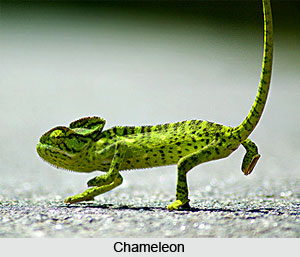 Chameleon is a unique group of arboreal lizard which is characterized by a long extendible tongue, watch-spring-like tail, protruding, independently moving eyes and toes opposed as in parakeets`. One of the species, Chameleo zeylanicus occurs in India and Sri Lanka. Chameleons have a remarkable ability to change colour. A Chameleon can change its colour from green and brown to different shades of yellow, white or black (but not red) in the space of a few minutes. Most chameleons are green and live among leaves, but they do not change colour to match their background. Their colour changes with the temperature and often becomes much brighter when chameleon meets another chameleon.
Chameleon is a unique group of arboreal lizard which is characterized by a long extendible tongue, watch-spring-like tail, protruding, independently moving eyes and toes opposed as in parakeets`. One of the species, Chameleo zeylanicus occurs in India and Sri Lanka. Chameleons have a remarkable ability to change colour. A Chameleon can change its colour from green and brown to different shades of yellow, white or black (but not red) in the space of a few minutes. Most chameleons are green and live among leaves, but they do not change colour to match their background. Their colour changes with the temperature and often becomes much brighter when chameleon meets another chameleon.
The chameleon`s eyes are set protruding turrets and can be rotated quite independently, so that the animal can see forward with one eye whilst looking sideways or backwards with the other. The eyes rotate ceaselessly in all directions till the prey is sighted, and when the chameleon makes up its mind to catch the prey the eyes stop rotating and focus on the abject, towards which the lizard advances with great deliberation. About twenty five centimetres away from its prey the Chameleon stops, aims with its head, rocks sideways the better to judge the distance, and suddenly the insect vanishes, having been snatched up by a lightning lick of the tongue.
The fore and hind feet of a chameleon are modified to form clasping organs suited for its life in bushes and trees. These grip branches so firmly that even a heavy wind cannot dislodge the animal. The tail is prehensile and helps the chameleon to negotiate gaps between branches. With all its unique features, a chameleon is a slow moving creature. When picked up it hisses and can inflict painful but harmless bites.
The Chameleon lives mainly upon insects which it eats in large quantities and great variety including agricultural pests such as grasshoppers. The female lays ten to thirty eggs (in winter months in South India). Eggs are laid in a hole in the ground dug by the female, and hatch about one hundred and twenty days later. A fully grown chameleon measures about three hundred and seventy five millimetres including its tail.



















